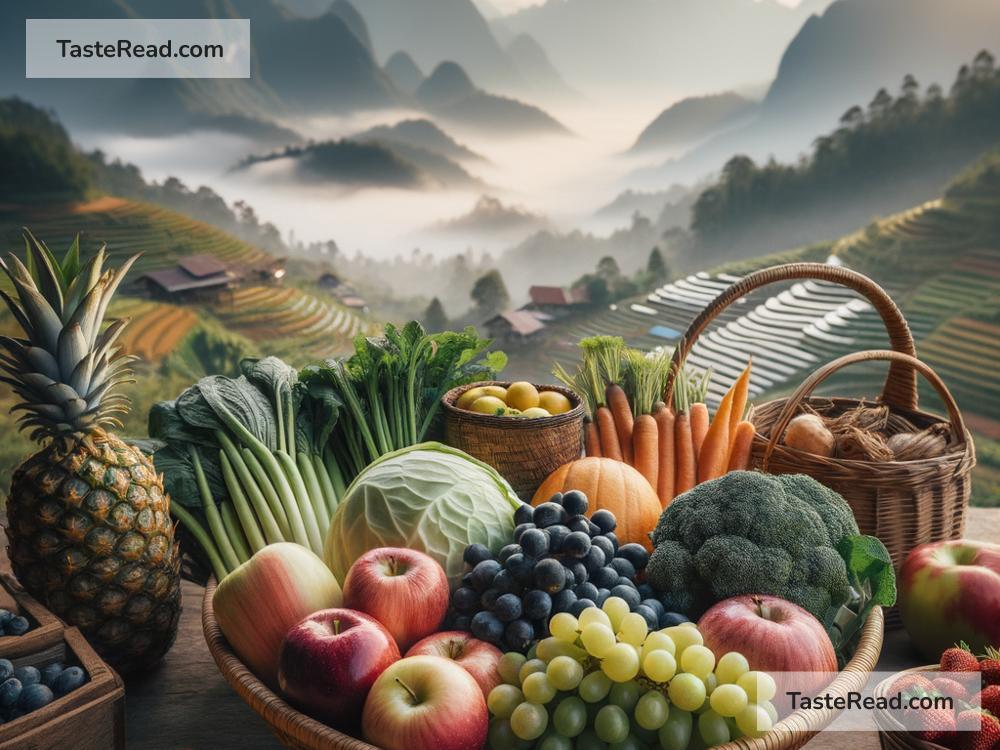The Influence of Altitude on the Aroma Compounds in Fruits and Vegetables
Fruits and vegetables are not only important for nutrition but are also cherished for their taste and smell. When you bite into a juicy apple or sniff the fragrant scent of a ripe mango, you’re experiencing the result of compounds known as “aroma compounds.” These compounds are chemical substances that give fruits and vegetables their unique smells and flavors. But did you know that altitude – the height above sea level – can play a role in shaping these aromas?
In this article, we’ll explore how altitude influences the aroma compounds in fruits and vegetables, why this matters, and how it impacts the way we enjoy the fresh produce grown in different regions of the world.
What are Aroma Compounds?
Aroma compounds are small molecules that evaporate and travel through the air to reach our noses. Each fruit or vegetable has its own mix of these compounds, which is why bananas smell different from strawberries, and tomatoes smell different from bell peppers. Aroma compounds are made up of chemicals like esters, aldehydes, ketones, and terpenes. They are naturally produced by fruits and vegetables as they ripen, making them more appealing to humans (and animals!) for consumption.
How Does Altitude Impact Fruits and Vegetables?
Altitude refers to how high a place is above sea level. At higher altitudes, the environment changes in several important ways. The air becomes thinner, temperatures are usually lower, and sunlight exposure tends to increase. These factors create a unique setting for plants grown at high altitudes compared to those grown at lower elevations.
-
Lower Temperatures
High-altitude areas usually have cooler temperatures than low-altitude places. Cooler temperatures can slow down the ripening process of fruits and vegetables. A slower ripening process often allows plants to develop their aroma compounds more gradually, leading to richer and more complex scents and flavors. For example, coffee plants grown at high altitudes tend to produce beans with stronger, more nuanced flavors. -
Increased Sunlight
Sunlight at high altitudes is often more intense due to reduced atmospheric filtering. This extra sunlight stimulates photosynthesis – the process by which plants create energy and grow. More sunlight can boost the production of certain aroma compounds, especially those related to sweetness and fruity scents. Fruits like apples and berries grown at higher elevations can sometimes have brighter, more aromatic profiles because of this increased sun exposure. -
Reduced Air Pressure
At higher altitudes, the air pressure is lower, meaning oxygen is less readily available. Plants adapt to this change by producing specific chemicals that help them survive in harsher conditions. Some of these chemicals include antioxidants and aroma compounds. This adaptation process makes high-altitude fruits and vegetables taste and smell different – often with more intense aromas – compared to those grown at lower elevations. -
Slower Growth
Fruits and vegetables grown at higher altitudes often take longer to mature because of cooler temperatures and other environmental factors. This slower growth allows for the gradual accumulation of sugars, acids, and aroma compounds, contributing to a better overall flavor. For example, potatoes grown in mountainous regions are often said to have a richer and earthier taste because of their slower growth.
Altitude and Specific Fruits and Vegetables
Different fruits and vegetables react to altitude in different ways. Let’s look at a few examples:
-
Coffee
Coffee beans grown in high-altitude regions are famous for their rich aroma and flavor. Cooler temperatures slow the ripening of the coffee cherries, allowing their sweetness and aromatic oils to develop more fully. -
Apples
Apples grown in mountainous regions often have a crisp texture and a sweeter scent thanks to cooler temperatures and sunlight. The slow ripening process allows the fruit to accumulate more sugars and aromatic compounds. -
Tomatoes
Tomatoes grown at higher altitudes tend to develop more intense, tangy flavors because of the unique balance of sugars and acids they produce in cooler environments. -
Herbs
Aromatic herbs like basil and mint grown at high altitudes may produce stronger scents because of increased sunlight and stress from lower air pressure. These environmental factors encourage the plants to create more essential oils, which give them their characteristic aromas.
Why Does This Matter?
The influence of altitude on aroma compounds is important not only for farmers but also for chefs, food enthusiasts, and anyone who loves fresh produce. Understanding how altitude affects the flavor and scent of fruits and vegetables helps farmers choose the best crops to grow in different environments. It also means consumers can enjoy foods with unique taste profiles based on where they’re grown.
For example, certain regions around the world—like the Andes Mountains, the highlands of Ethiopia, and the valleys of northern India—are famous for producing fruits, vegetables, and coffee with exceptional aroma and taste because they are grown at high altitudes. Knowing this helps people appreciate the connection between geography and the food they enjoy.
Final Thoughts
Altitude plays a surprisingly important role in determining the aroma and flavor of fruits and vegetables. Factors like cooler temperatures, increased sunlight, and slower growth all contribute to the development of richer and more complex aroma compounds. As a result, fruits and vegetables grown at higher elevations often have unique scents and tastes compared to those grown at lower altitudes.
Next time you enjoy a high-altitude apple or sip on coffee from a mountainous region, take a moment to think about the environment that shaped its aroma and flavor. What’s on your plate is more than just food—it’s a story of nature, altitude, and the remarkable ways plants adapt to their surroundings!


